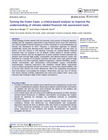Taming the Green Swan: a criteria-based analysis to improve the understanding of climate-related financial risk assessment tools
dc.contributor.author
Bingler, Julia Anna
dc.contributor.author
Colesanti Senni, Chiara
dc.date.accessioned
2022-03-10T09:56:58Z
dc.date.available
2022-02-15T03:51:32Z
dc.date.available
2022-03-10T09:56:58Z
dc.date.issued
2022
dc.identifier.issn
1752-7457
dc.identifier.issn
1469-3062
dc.identifier.other
10.1080/14693062.2022.2032569
en_US
dc.identifier.uri
http://hdl.handle.net/20.500.11850/532556
dc.identifier.doi
10.3929/ethz-b-000532556
dc.description.abstract
Understanding climate-related risks has become a key priority in financial decision-making and for regulatory supervision in the financial sector since the Task-force on Climate-related Financial Disclosures (TCFD) launched its recommendations on climate risk disclosures in 2017. However, a systematic approach to identify scientifically sound and decision-useful climate risk indicators and the tools to derive such risk metrics is still missing. Focusing on climate-related financial transition risks, we propose a set of analysis criteria rooted in climate science, economics, finance, and risk management, to assess whether climate transition risk analysis tools provide high quality, comparable, and decision-relevant results. We find that for a sample of 16 climate transition risk tools, some tools perform high on all criteria, but that especially model transparency, scenario flexibility, output-related uncertainties, and assumptions communication require considerable improvements. Financial supervisors and regulators should define appropriate ways to obtain comparable climate risk metrics, to ensure their interpretability, and to ensure that climate risk metric disclosures reflect the underlying assumptions and uncertainties surrounding the analyses. Researchers and any user of climate risk metrics should carefully understand and report the analysis tools' setup, and interpret their findings in light of the analysis assumptions. Key policy insights Providers of climate risk analysis tools should increase transparency on the tools' setup in standardized templates. Reporting templates should include information on whether the tool has been peer-reviewed, the depth of risk analysis, key modelling steps and underlying assumptions. Firms should report the tool setup and modelling assumptions in their voluntary climate-related disclosures. In addition, uncertainties surrounding the analysis should be reported, for example, via confidence intervals or probability distributions. Financial regulators and corporate reporting regulation should ensure that mandatory climate risk disclosures are understandable and comparable. Regulators should ask firms to disclose their risks based on harmonized climate risk metrics disclosure templates, to ensure that key assumptions, the model setup, limitations of the analyses and analysis uncertainties are reported alongside the metrics.
en_US
dc.format
application/pdf
en_US
dc.language.iso
en
en_US
dc.publisher
Taylor & Francis
en_US
dc.rights.uri
http://creativecommons.org/licenses/by-nc-nd/4.0/
dc.subject
Climate risks
en_US
dc.subject
transition risks
en_US
dc.subject
climate-adjusted financial risk indicators
en_US
dc.subject
criteria-based analysis
en_US
dc.title
Taming the Green Swan: a criteria-based analysis to improve the understanding of climate-related financial risk assessment tools
en_US
dc.type
Journal Article
dc.rights.license
Creative Commons Attribution-NonCommercial-NoDerivatives 4.0 International
dc.date.published
2022-02-06
ethz.journal.title
Climate Policy
ethz.journal.volume
22
en_US
ethz.journal.issue
3
en_US
ethz.pages.start
356
en_US
ethz.pages.end
370
en_US
ethz.size
15 p.
en_US
ethz.version.deposit
publishedVersion
en_US
ethz.code.jel
JEL - JEL::C - Mathematical and Quantitative Methods::C8 - Data Collection and Data Estimation Methodology; Computer Programs::C83 - Survey Methods; Sampling Methods
en_US
ethz.code.jel
JEL - JEL::D - Microeconomics::D5 - General Equilibrium and Disequilibrium::D53 - Financial Markets
en_US
ethz.code.jel
JEL - JEL::D - Microeconomics::D8 - Information, Knowledge, and Uncertainty::D81 - Criteria for Decision-Making under Risk and Uncertainty
en_US
ethz.code.jel
JEL - JEL::G - Financial Economics::G1 - General Financial Markets::G12 - Asset Pricing; Trading Volume; Bond Interest Rates
en_US
ethz.code.jel
JEL - JEL::G - Financial Economics::G3 - Corporate Finance and Governance::G32 - Financing Policy; Financial Risk and Risk Management; Capital and Ownership Structure; Value of Firms; Goodwill
en_US
ethz.code.jel
JEL - JEL::Q - Agricultural and Natural Resource Economics; Environmental and Ecological Economics::Q5 - Environmental Economics::Q54 - Climate; Natural Disasters and Their Management; Global Warming
en_US
ethz.notes
This work was supported by WWF Switzerland.
en_US
ethz.identifier.wos
ethz.identifier.scopus
ethz.publication.place
Abingdon
en_US
ethz.publication.status
published
en_US
ethz.leitzahl
ETH Zürich::00002 - ETH Zürich::00012 - Lehre und Forschung::00007 - Departemente::02120 - Dep. Management, Technologie und Ökon. / Dep. of Management, Technology, and Ec.::03635 - Bretschger, Lucas (emeritus) / Bretschger, Lucas (emeritus)
en_US
ethz.relation.isNewVersionOf
20.500.11850/428321
ethz.date.deposited
2022-02-15T03:52:38Z
ethz.source
WOS
ethz.eth
yes
en_US
ethz.availability
Open access
en_US
ethz.rosetta.installDate
2022-03-10T09:57:09Z
ethz.rosetta.lastUpdated
2024-02-02T16:30:15Z
ethz.rosetta.versionExported
true
ethz.COinS
ctx_ver=Z39.88-2004&rft_val_fmt=info:ofi/fmt:kev:mtx:journal&rft.atitle=Taming%20the%20Green%20Swan:%20a%20criteria-based%20analysis%20to%20improve%20the%20understanding%20of%20climate-related%20financial%20risk%20assessment%20tools&rft.jtitle=Climate%20Policy&rft.date=2022&rft.volume=22&rft.issue=3&rft.spage=356&rft.epage=370&rft.issn=1752-7457&1469-3062&rft.au=Bingler,%20Julia%20Anna&Colesanti%20Senni,%20Chiara&rft.genre=article&rft_id=info:doi/10.1080/14693062.2022.2032569&
Files in this item
Publication type
-
Journal Article [128972]

